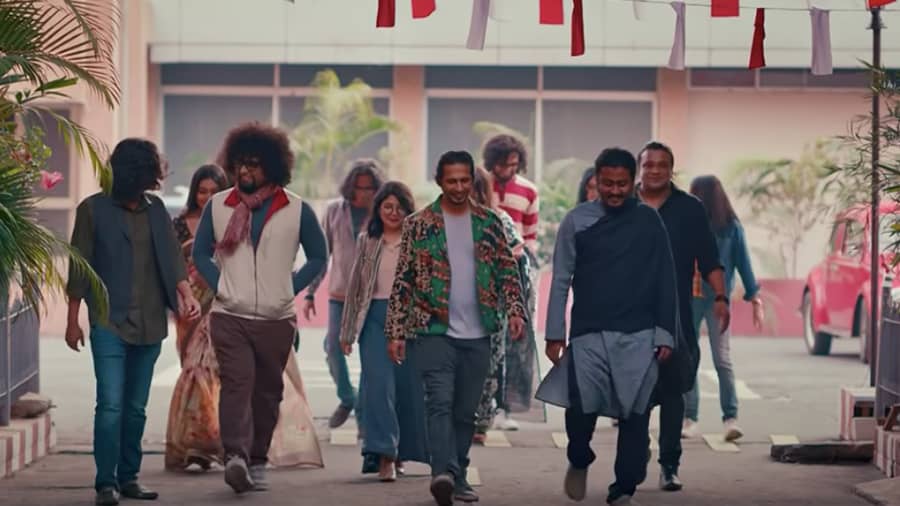The octagonal, swarthy face with narrow rectangles for eyes, a mouth of similar shape and nose resembling a sledgehammer is framed in hair that looks like a pentagonal cap. The head stands on straight shoulders. Going by its facial features and complexion, it could belong to a member of the indigenous communities. It has a fixed stare that would be associated with that of a robot. The background is blank.
The dark tone is achieved by dense hatching with dark brown, blue and burnt sienna crayons. The name of the artist and the year of execution were once clearly visible in the bottom right hand corner of the drawing but it is now smudged, probably because of the too generous use of adhesive to hold the flimsy paper together.
However, the signature and date can still be discerned in a reproduction of the same work in Prabaha, a catalogue edited by Pabitra Sarkar for the Exhibition of Art of Bengal 1850 to 1999 on the occasion of the Biswa Banga Sammelan Millennium Festival, December 29, 1999, to January 9, 2000.
In that reproduction, the name Rabindranath Tagore and the year 1936 can be clearly read when held under a magnifying glass.
In less than two weeks, for the second time, this drawing by Rabindranath will be exhibited — again in Calcutta. When it was first displayed at the turn of the millennium, the drawing had not drawn much attention. Rabindranath’s art works are highly valued in the international market and they are difficult to come by.

Paharadar, the drawing by Rabindranath Tagore. The Telegraph
The work so long has been in the possession of the family of the renowned portrait artist Atul Bose (1898-1977), who had in 1936 painted from life a portrait of Rabindranath in Santiniketan. Rabindranath had gifted Atul Bose this work after he was done with his portrait.
“This is a genuine work with a background history that is believable. The time attributed to it is 1936. Atul Bose’s visit to Santiniketan is a recorded fact. Benode Behari Mukherjee wrote about it in his Chitrakar (his memoir). It is absolutely possible that it was a gift,” says R. Siva Kumar, leading Indian art historian, art critic, curator and researcher.
As to the style of the work, Siva Kumar added: “It goes a little close to what Rabindranath was doing by way of illustrating Khapchhada, particularly the cover. He used crayon to do quite a few images of the 1936-37 period. He depicted various characters like Sukumar — people he saw around himself, but not belonging to the same class as himself.”
Sushobhan Adhikary, former curator, Kala Bhavana Museum, Santiniketan, says: “Rabindranath did similar faces with Pelican waterproof ink but those have greater depth. As in Khapchhada, the male faces are angular and rather stiff. Caricature-like. The female faces are, however, oval. Rabindra Bhavana plus Kala Bhavana have nearly 1,700 such images, and in his manuscripts, too, there are about 200 to 250 images which are not identified separately.
“This drawing has a distinct character with its features being close to those of indigenous communities. After he crossed 60, the style of Rabindranath’s doodling began to change. These designs that had appeared in his manuscripts came alive once again in the images he did on any scrap of paper he could lay his hands on after he turned 60. He never checked the paper’s quality that he doodled on later. This drawing too must have been done on such a piece.”
Debovasha, the art gallery at 9/2 Fern Road, will hold an exhibition of this single work titled Paharadar for three days from Baishe Shraban, the death anniversary of Rabindranath that falls on August 6. This is part of the gallery’s 10th anniversary celebration.
According to Kamal Sarkar’s invaluable Bharater Bhaskar O Chitrashilpi, Atul Bose was born in Mymensinh in former East Bengal and was initially trained at Jubilee Art Academy, and thereafter at the Government Art School from where he passed out with flying colours.
Thereafter, he was sent to London’s Royal Academy where he was trained by the likes of Walter Richard Sickert. He had mastered the academic style and done the portraits of the leading lights of his time.
Sarkar confirms that Rabindranath had sat for his portrait to be painted by Atul Bose in 1936 and that after Independence, West Bengal governor Chakravarti Rajagopalachari had acquired it. It now hangs in the Raj Bhavan “study”.
Atul Bose has left behind three sons — Abhijit, Sanjit and Dipankar. Octogenarian Sanjit Bose, who has retired as professor at the Indian Statistical Institute, says in a video message that his father had long desired to paint a portrait of Rabindranath from life.
Around the year 1936-37, Charuchandra Dutt, a retired ICS closely associated with Visva Bharati and personally acquainted with Rabindranath, communicated to the poet Atul Bose’s desire to paint his portrait. Rabindranath agreed readily.
After the portrait was completed, Rabindranath was visibly moved by it. “How did you get me?” he asked Atul Bose. It is a sombre painting and the poet is in a “philosophical, pensive” mood.
Unknown to the artist, the poet had drawn an image. “All these days you had kept a watch on me. So I am giving you a picture of a watchman or paharadar,” the poet told the artist. The artist later narrated this incident to his sons.












